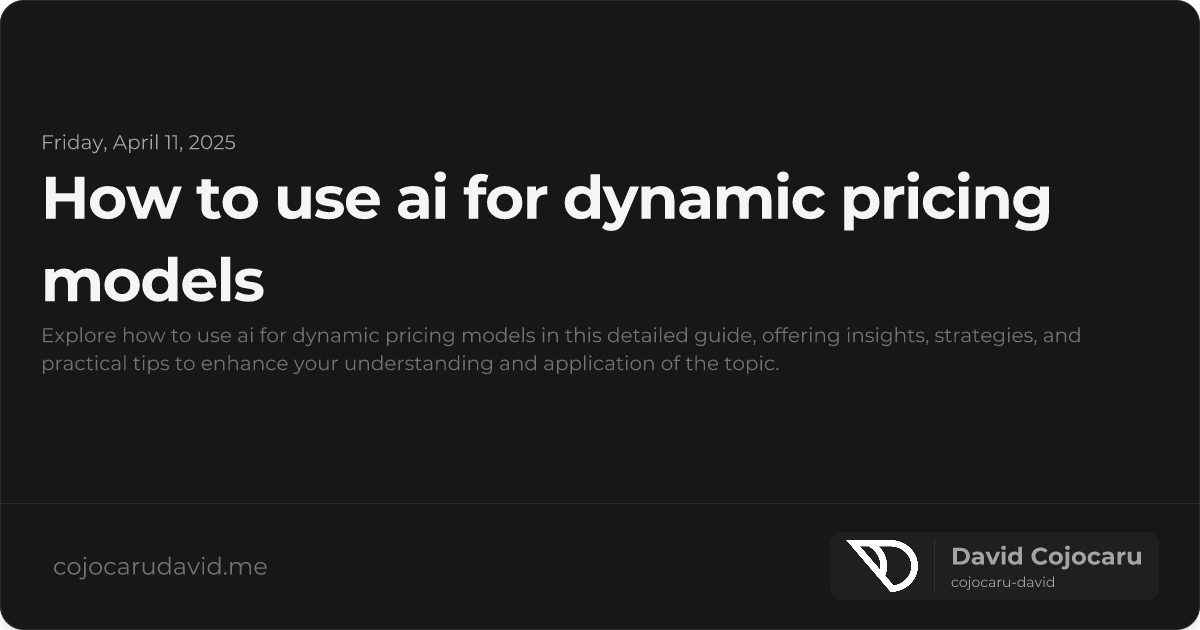Unlock Smarter Pricing: How to Use AI for Dynamic Pricing Models
Dynamic pricing is no longer a futuristic concept; it’s a business imperative. By adjusting prices in real-time based on demand, competition, and a host of other factors, dynamic pricing can significantly boost profitability. And now, Artificial Intelligence (AI) is revolutionizing how businesses approach this powerful strategy. In this guide, we’ll delve into how to use AI for dynamic pricing models, exploring the benefits, practical implementation steps, and potential challenges. Get ready to unlock smarter, data-driven pricing decisions.
What is AI-Powered Dynamic Pricing?
AI-powered dynamic pricing goes beyond traditional rules-based approaches. It leverages the power of machine learning (ML) and advanced data analytics to automatically set optimal prices. Instead of relying on static formulas, AI algorithms analyze massive datasets – including competitor pricing, customer behavior, seasonality, and even external events – to make real-time price adjustments that maximize revenue and market share.
The key advantages speak for themselves:
- Boosted Revenue: Capture peak demand and optimize pricing to maximize revenue generation.
- Enhanced Competitiveness: React swiftly to market changes and stay ahead of the competition with agile price adjustments.
- Personalized Customer Experiences: Offer tailored pricing based on individual customer segments and preferences, driving loyalty and conversion.
How AI Supercharges Dynamic Pricing
1. Real-Time Data Analysis: The Foundation of Intelligent Pricing
AI can process a continuous stream of live data from diverse sources, including:
- Historical sales data: Identifying patterns and trends in past performance.
- Competitor pricing: Monitoring competitor strategies and adjusting accordingly.
- External factors: Factoring in weather, events, holidays, and other real-world influences.
This comprehensive analysis ensures your pricing always reflects the most up-to-date market conditions.
2. Demand Forecasting: Predicting the Future of Demand
Machine learning models excel at predicting future demand by identifying subtle patterns and correlations within vast datasets. Consider these examples:
- Ride-sharing surge pricing: Automatically increasing prices during peak hours to balance supply and demand.
- Retail promotions: Offering targeted discounts during slow periods to drive sales and clear inventory.
3. Competitor Price Monitoring: Staying One Step Ahead
AI-powered tools can automatically scrape competitor pricing data from e-commerce platforms and other sources, allowing you to:
- Track price changes in real-time: React instantly to competitor actions and maintain a competitive edge.
- Identify promotional strategies: Analyze competitor discounts and promotions to inform your own pricing decisions.
Implementing AI for Dynamic Pricing: A Step-by-Step Guide
Step 1: Define Clear Pricing Objectives
Before diving into the technical aspects, define your core objectives:
- Maximize profit margins: Focus on increasing profitability per sale.
- Grow market share: Prioritize gaining a larger share of the market.
- Optimize inventory turnover: Clear excess inventory quickly and efficiently.
Step 2: Collect and Prepare Your Data
Data is the fuel that powers AI. Gather both structured and unstructured data, including:
- Internal data: Sales history, customer demographics, product costs, and inventory levels.
- External data: Competitor pricing, market trends, economic indicators, and social media sentiment.
Data cleaning and preparation are crucial for model accuracy.
Step 3: Select the Right AI Model
Choose an AI model that aligns with your pricing objectives and data availability. Popular options include:
- Regression models: Ideal for understanding price elasticity and the relationship between price and demand.
- Neural networks: Powerful for complex pattern recognition and handling non-linear relationships.
- Reinforcement learning: Best suited for adaptive pricing in dynamic environments where the model learns through trial and error.
Step 4: Test, Iterate, and Optimize
Rigorous testing is essential. Run simulations and A/B tests to refine your pricing strategies before full-scale deployment. Continuously monitor performance and make adjustments as needed.
Addressing the Challenges of AI-Powered Pricing
Challenge: Data Privacy Concerns
The use of customer data raises legitimate privacy concerns.
Solution: Implement robust data anonymization techniques, comply with regulations like GDPR and CCPA, and be transparent with customers about how their data is being used.
Challenge: Algorithm Bias
Biased training data can lead to unfair or discriminatory pricing.
Solution: Regularly audit your models for fairness and transparency, and actively mitigate bias in your datasets.
Conclusion: Embrace the Future of Pricing
AI-driven dynamic pricing is transforming how businesses approach pricing, offering unprecedented levels of agility, precision, and personalization. By leveraging the power of machine learning and real-time analytics, companies can stay ahead of the competition, maximize revenue, and build stronger customer relationships.
“AI doesn’t just adjust prices; it uncovers hidden opportunities and predicts the future of demand.”
Ready to revolutionize your pricing strategy? Start exploring the potential of AI today and unlock a new era of smarter, data-driven pricing decisions.

